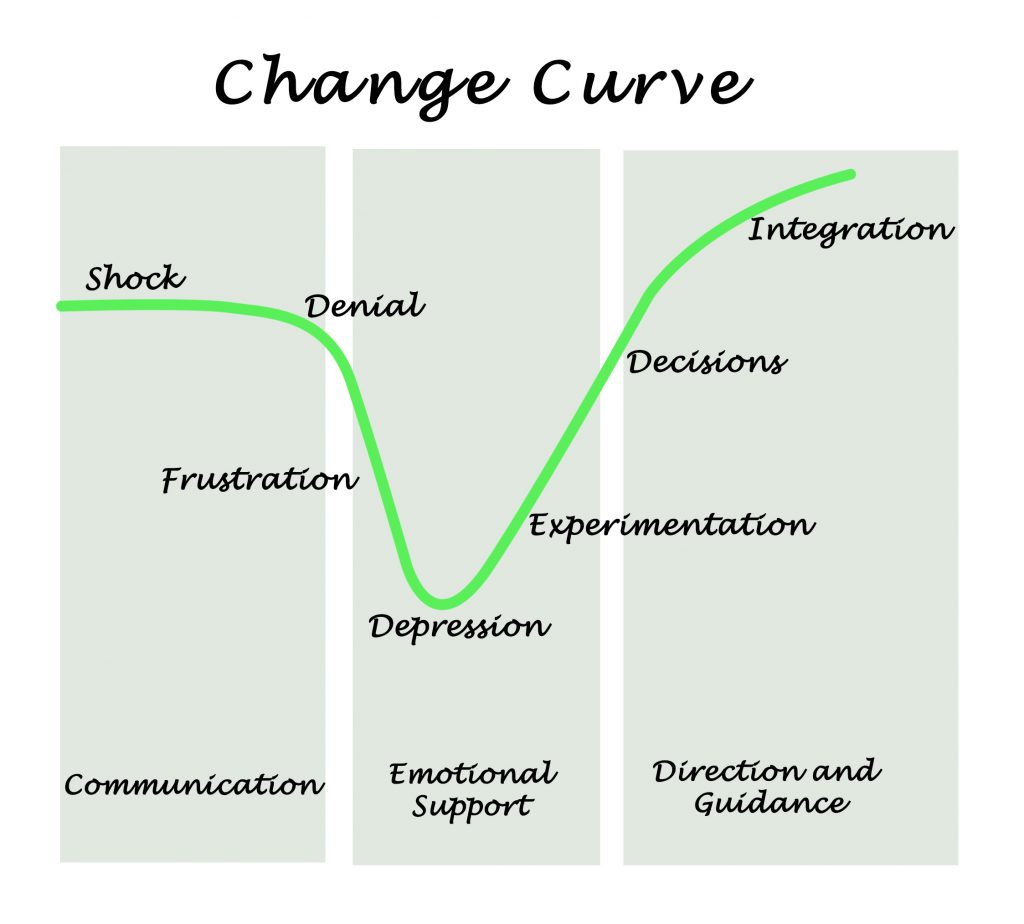This post was written by a colleague and dear friend, Linda Cattelan who has granted permission for its use here.

“Its been more than 6 months since the COVID-19 pandemic first hit our awareness. As I reflected on all that has transpired over the past several months, the realization that our lives will never be the same again, and the impact this pandemic has had on me, others and the global community at large; it occurred to me that this crisis (while on a huge scale), nevertheless, could be explained by “the Change Curve”.
The ”Change Curve” is a model originally developed in the 1960s by Elisabeth Kubler-Ross to explain the grieving process. Since then, the model has been used in many different contexts to help people understand their reactions to significant change or upheaval. By the 1980’s the Change Curve was a regular model/process used in change management practices. The curve is used to predict how people’s performance could be impacted by significant announcements, implementation and change. There are many versions of the model in existence today. However, the majority are consistent in using variations of the original basic emotions of denial, anger, depression, and acceptance.
Let’s consider each of the emotions on the change curve. As you do, determine if you can relate to the emotion or if it’s an emotion you have already passed through sometime over the past several months:
1. Shock – The first reaction is usually shock. For some people, this is quite short-lived. For others it can take some time to work through the shock. During this period, time seems to slow down. Productivity can be lost or significantly reduced. Individual and group performance can dip and even employees who are usually clear and proactive may need more direction, reassurance and validation. The shock occurs due to a lack of information, a fear of the unknown, or a fear of making a wrong move.
2. Denial – Once the initial shock has passed, it is common for people to experience denial. There is a focus on the past. “The way things used to be”. Even if the past was not great, the feeling is that everything was okay as it was. Some people can be so affected, that it is common for them to convince themselves that it is actually “not happening”. We certainly, saw lots of evidence of “denial” as some people went about “business as usual” in group gatherings, not wearing masks nor socially distancing, despite pleas from various levels of government. As a leader, regular communication with your employees is very important during this time, providing them as much reassurance and support as you can to help them get through the change as well as deal with their emotions.
3. Anger – Anger often follows shock and denial. People may look for someone or something to blame. Suspicion, scepticism and frustration are common. We can point to numerous conspiracy theories that have emerged during COVID-19 as examples on display. As the leader, acknowledging your employees’ anger and frustration can be helpful, even if you don’t have a solution for them. Often, employees just need to be heard.
4. Depression – As the anger wears off, and the realization of the change sets in, this is often the lowest point on the change curve. Individual and group performance, productivity and even employee morale are usually at their lowest. Some individuals start to fixate on minor issues or problems, while other individuals may experience self-doubt and even varying degrees of anxiety. Some find it challenging to express or label their feelings of depression. As the leader, let your employees know that others are feeling similar emotions. Let them know that what they are experiencing is common.
5. Acceptance – Finally on the other side of the darker emotions, a more optimistic perspective begins to emerge. People finally accept what is going on and that the change is here to stay. Once they have accepted the “new normal”, they can start to work with the change instead of against it. Some individuals may even get excited about new possibilities and opportunities. Some will be relieved that they “survived” the change and may be settling into a “new normal”. Others may be impatient for the change to finally be over with. As the leader, providing specifics regarding task completion and changes in responsibilities remains key. There is no such thing as over-communication. Remember too, that positive feedback and praise goes a long way with your employees.
6. Integration – The final step is integration. The focus is “where do we go from here”. The new reality embedded, performance back on track, the primary feelings now include: acceptance, hope and trust. As the leader, your role is to keep the communication flowing and anchor the acceptance, hope and trust.
Every individual is different and therefore it is difficult to predict how quickly you and your employees will move through the change curve. Some may be stuck in certain stages for long periods of time as they make sense of the situation for themselves, while others will move through the curve more rapidly. However, knowing where you or your employees are on the change curve, will help you identify the best strategies to use to move yourself forward and to support others in the process.

